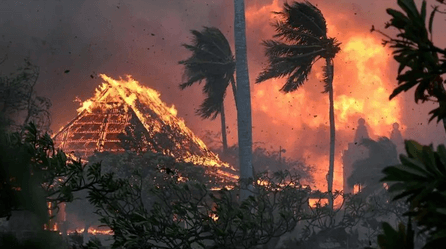“We need to accept the reality we find ourselves in – that climate change is already here”, says Claire Jervis, Associate Fund Manager at WHEB Asset Management. Here, Claire explains why WHEB has introduced a new and increasingly important investment sub-theme: climate adaptation.

“I think I need a new colour,” reflects Professor Ed Hawkins, creator of the ‘Climate Stripes’ image.
The Climate Stripes is a series of vertical coloured bars that offers a visual representation of how our planet is progressively heating up over time.
Shades of blue indicate cooler than average years1 while Red shows years that were hotter than average. Professor Hawkins, a climate scientist at the University of Reading, created the image in 2018.
But temperatures were so high in 2023 that a new, darker shade could now be needed.
Climate change costs more than money
It is well established that rising global temperatures are strongly correlated with extreme weather events2. Carbon Brief, an award-winning climate journal, has mapped and analysed over 400 scientific studies on this subject. They found that over 70 per cent of the extreme weather events studied were exacerbated by human-caused climate change3.
Behind these figures are hundreds of weather events around the world. Each caused tragedy and devastation. Munich RE, a reinsurance firm, estimates that natural disasters caused $250 billion (£198 billion) in financial losses in 2023 alone. Over 74,000 lives were lost4.

Hawaii: ‘Apocalyptic’ wildfires leave at least 53 dead on island of Maui (5)
We need to adapt
The world is not investing enough to prevent climate change. The result is an ever-hotter climate and increasing natural disasters. And make no mistake – it is killing people.
We investors do what we can. We buy shares in impactful companies. We engage with corporations to reduce their emissions. We work with policymakers to accelerate change. But we also need to accept the reality we find ourselves in.
With that in mind, WHEB has formally established a Climate Adaptation sub-theme in our investment strategy. This forms part of our Environmental Services theme. Importantly, this new sub-theme changes nothing about how our strategy is managed. In fact, we have been investing in adaptation for years.
Rather, it formally acknowledges the crucial role of adaptation investment. It also, potentially, creates opportunities for new companies to enter our investment universe. For example, we recently spoke to a company which has experienced rapid growth from selling hurricane-resistant windows in Florida.
Investing in Climate Adaptation
Today, about five per cent of WHEB’s global fund is invested in companies supporting climate adaptation6. My favourite is probably Advanced Drainage Systems (ADS). This remarkable company sells plastic stormwater pipes in America.
The company’s products are crucial for helping communities become more resilient to flooding. ADS has seen huge revenue growth and margin expansion as its products are increasingly seen as critical infrastructure.
Environmental consultants Arcadis are another example of an investee company supporting climate adaptation. They have been working on projects to shore up flood defences7; transform concrete jungles into green spaces8; and create stormproof sewers9. Arcadis has seen rapidly increasing demand for its services over the last few years.
Spend now, save later
Investing in climate adaptation does not mean we are admitting defeat. Spending on mitigation measures like cleaner energy must, and will, continue. But it is important to realise that investing in climate-resilient infrastructure today can avoid even greater costs in the future. The UN estimates that spending $1.8 trillion (£1.42 trillion) on a variety of adaptation projects could generate four times that amount in avoided costs and benefits10.
And, more importantly, these investments could save lives. That is surely invaluable.
1 The average temperature is set as the average temperature between 1971-2000.
2 https://www.ipcc.ch/report/ar6/syr/
3 https://www.carbonbrief.org/mapped-how-climate-change-affects-extreme-weather-around-the-world/
4 https://www.munichre.com/en/company/media-relations/media-information-and-corporate-news/media-information/2024/natural-disaster-figures-2023.html
5 https://www.itv.com/news/2023-08-09/hawaii-people-jump-into-sea-to-escape-apocalyptic-wildfires
6 As of December 31, 2023.
7 https://www.arcadis.com/en-gb/projects/north-america/united-states/redefining-adaptation-to-build-a-fit-for-future-coastal-community
8 https://www.arcadis.com/en-gb/projects/europe/france/forets-urbaines-a-paris
9 https://www.arcadis.com/en-gb/projects/europe/netherlands/op-weg-naar-een-klimaatbestendig-utrecht
10 https://www.un.org/en/climatechange/climate-adaptation



